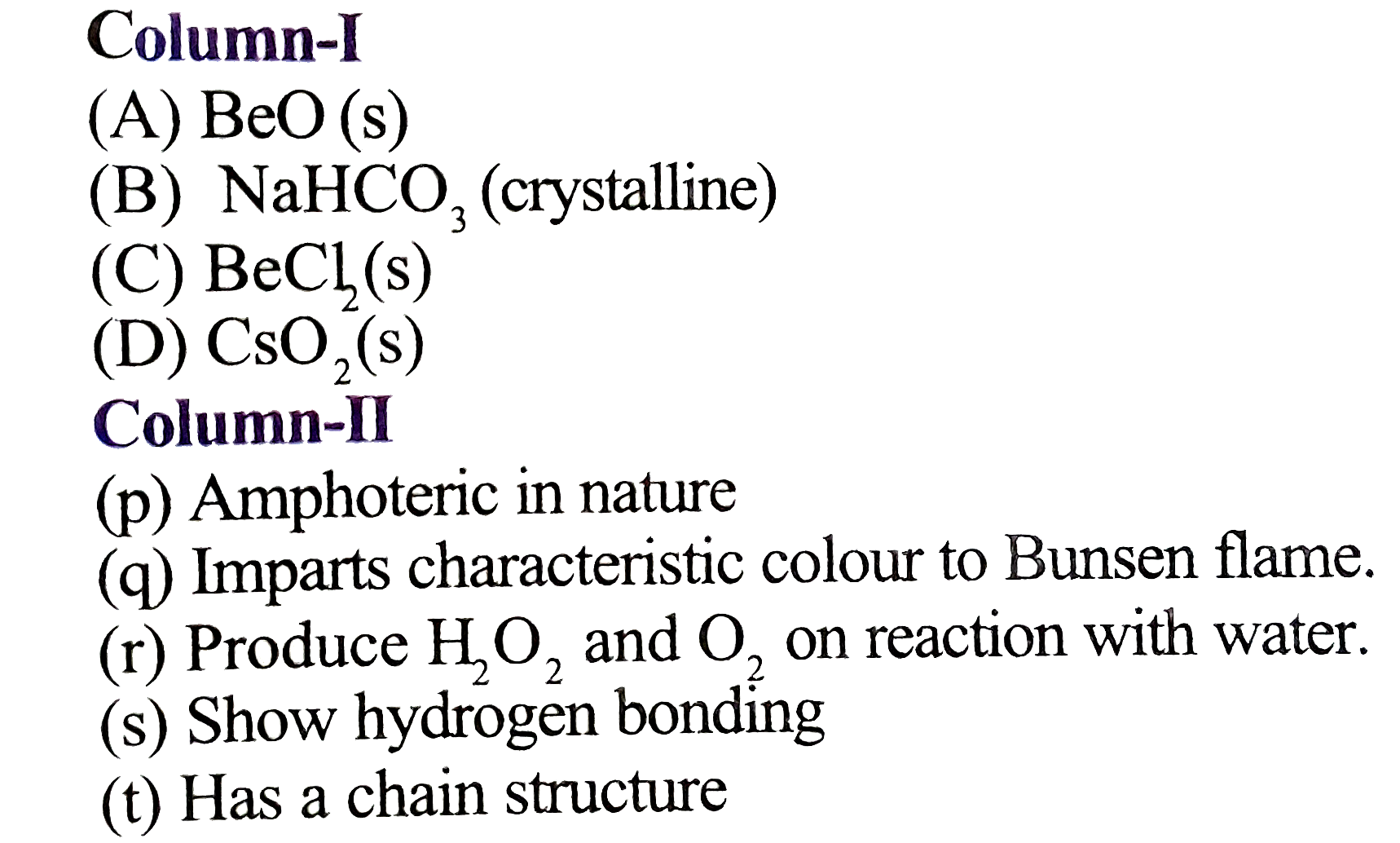Match the Column-I with Column-II :
List-I List-II(A)CuSO4P.Cationic interaction(B)Na2CO3Q.Anionic interaction(C)FeCI3R.pH>7(D)K2SO4S.pH<7T.No hydrolysis of ionsSolution in Telugu
The correct Answer is:A-PS; B-QR; C-PS; D-P
Cu2+ gets hydrolysis ⇒ acid solution ⇒pH<7
CO2−3 get hydrolysis ⇒ basic solution ⇒pH>7
Fe+3 gets hydrolysis ⇒ acid solution ⇒pH<7
K+andSO2−4 dont get hydrolysed
Topper's Solved these Questions
- IONIC EQUILIBRIUM Book:AAKASH SERIESChapter:IONIC EQUILIBRIUM Exercise:PRACTICE SHEET (EXERCISE -III LEVEL -II (ADVANCED) (Integer Type Questions))
Explore 8 Videos
- IONIC EQUILIBRIUM Book:AAKASH SERIESChapter:IONIC EQUILIBRIUM Exercise:PRACTICE SHEET (EXERCISE -IV LEVEL -I (MAIN) (Straight Objective Type Questions))
Explore 24 Videos
- IONIC EQUILIBRIUM Book:AAKASH SERIESChapter:IONIC EQUILIBRIUM Exercise:PRACTICE SHEET (EXERCISE -III LEVEL -II (ADVANCED) (Linked Comprehension Type Questions))
Explore 6 Videos
- HYDROGEN AND ITS COMPOUNDSBook:AAKASH SERIESChapter:HYDROGEN AND ITS COMPOUNDSExercise:QUESTIONS FOR DESCRIPTIVE ANSWERS
Explore 20 Videos
- ISOMERISM Book:AAKASH SERIESChapter:ISOMERISM Exercise:ADDITIONAL PRACTICE EXERCISE ( PRACTICE SHEET (ADVANCED) INTEGER TYPE QUESTIONS)
Explore 10 Videos
Similar Questions
Certain weak acid has Pka = 4. Find pH of 0.01M NaA(ag)
View SolutionThe human eye is sensitive to colour differences of indicator only when the ratio [In−]/[H∈] is greater then 10 (or) smaller than 0.1. What should be the minimum change in the pH of solution of observe a complete colour change .(pKIn=5) .
View SolutionWhen a salt reacts with water to form acidic (or ) basic solution the process is called salt hydrolysis. The PH of salt solution can be calculated using the following relation PH=12[Pkw+PKa+logC] for salt of weak acid and strong base.
PH=12[PKw−PKa−logC] for salt of weak base and strong acid ,PH=12[PKw+PKa−PKb]
For a salt of weak acid and weak base where .c. represents the concentration of salt . When a weak acid (or) a weak base is not completly neatralised by strong base (or ) strong acid respectively, then formation of buffer takes places. The PH of buffer solution can be calculated using the following relation
PH=PKa+log([salt)][Acid ],POH=PKb+log[salt][base]
Answer the following questions using the following data
pKa(CH3COOH)=4.7447,pKb(NH4OH)=4.7447,PKW=14.
0.001 M NH4Cl aqueous solution has PH
View SolutionWhy the use of hard water is disadvantages?
View SolutionTautomerism is exhibited by X number of compounds among the following. What is X.

View SolutionMatch the List -I (containing anions ) with List -II (containing reagent used in testing ) using the codes as given below in the column.
List−IList−II(anions)(reagents)(a)S2−(p)Barium chloride solution in presence of HCl(b)NO−3(q)Sodium nitroprusside(c)I−(r)chlorine water and chloroform(d)SO2−4(s)iron(II)sulphate solution and conc.H2SOS4
Code :
View SolutionMatch the complexed listed column −I with type of hybridisation listed in column −II and select the correct answer using the code given below the lists :
Column−IColumn−II(a)[AuF4]−(p) dsp2hybridisation(b)[Cu(CN)4]3−(q) sp3hybridisation(c)[Co(NH3)6]3+(r) sp3d2hybridisation(d)[Fe(H2O)5NO]2+(s) d2sp3hybridisation
View SolutionMatch the compounds listed in column -I with the characteristic(s) listed in column-II.

View SolutionMatch the complexes listed in column-I with characteristic(s) listed in column-II.
View SolutionColumn IColumn II(A)CH3COONa(i)Almost neutralpH>7or <7(B)NH4CI(ii)AcidicpH<7(C)NaNO3(iii)Alkaline pH>7(D)CH3COONH4(iv)Neutral pH=7
View SolutionMatch the species listed in column-I with the characteristics/propertie listed in column-II. {:("Column-I","Column-II"),((A)C_2,(p)"Diamagnetic"),((B)N_2,(q)"Undergoes oxidation"),((C )O_2^(2-),(r)"Undergoes reduction"),((D )F_2,(s)"Bond order"ge2),(,(t)"No mixing of 's' and 'p' orbitals"):}
View Solution{:(" Column - I"," Column - II(Uses)"),(" a) "Na_(2)CO_(3)," P) ""Fungicide"),(" b) "CuSO_(4)*5H_(2)O," Q) ""Medicine"),(" c) "NaHCO_(3)," R) ""Preservative"),(" d) "NaCl," S) ""Textile"):}
View SolutionMatch the stoichiometric coefficients listed in Column II with the species listed in Column I that are involved in the balanced equation of the reaction : {:(,"LIST -I",,"LIST -II"),((P),FeC_(2)O_(4),(1),10),((Q),MnO_(4)^(-),(2),24),((R),H^(+),(3),5),((S),CO_(2),(4),3):}
View SolutionMatch Column - I with Column - II. {:(,"Column - I",,"Column - II"),((A),"NaCl"("C.N. of "Na^(+)),(p),4),((B),"ZnS"("C.N. of "Zn^(+2)),(q),3),((C ),CaF_(2)("C.N. of "Ca^(2+)),(r ),6),((D),"CsCl"("C.N. of "Cs^(+)),(s),8),(,,(t),"anion in alternate tetrahedral void."):}
View SolutionMatch Column -I with Column -II {:("Column-I","Column-II"),((A)"Sorel's cement",(p)MgCl_(2)),((B)"Albite",(q)MgO),(( C)"A salt of carnallite",( r) NaAlSl_(3)O_(8)),((D)"Glauber's salt",(s) Na_(2)SO_(4).10H_(2)O):}
View SolutionList-I List-II(A)SiF4P.Lewis acid(B)CO2Q.Lewis base(C)SO2R.Bronstead acid(D)NH3S.Bronstead base
View Solution

